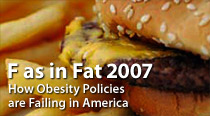


|
|
|
|
|
|
|
|
|
|
|
|
||||||||||||||
|
||||||||||||||
|
|
||||||||||||||
|
||||||||||||||
|
Posted
08/27/2007
In a tie with Tennessee, some 27.8 percent of S.C. adults are obese, according to a report by Trust for America's Health (TFAH), This year's report, for the first time, looked at obesity rates among children ages 10 to 17. The Palmetto State ranked seventh highest at 18.9 percent. South Carolina's adult obesity numbers have worsened with each report by the TFAH. In 2004, the state ranked 13th with an obesity rate of 24.5 percent. The fourth annual F as in Fat: How Obesity Policies Are Failing in America, 2007 report found that adult obesity rates rose in 31 states in the U.S. over the past year, and adult obesity rates now exceed 25 percent in 19 states. No state experienced a decrease in obesity. Eight-five percent of Americans believe obesity is an epidemic, according to a public opinion survey also featured in the report. Mississippi topped the list with the highest rate of adult obesity in the country for the third year in a row, and is the first state to reach a rate of over 30 percent (at 30.6 percent). Ten of the 15 states with the highest rates of adult obesity are located in the South. Colorado was the leanest state again this year, however, its adult obesity rate increased over the past year (from 16.9 to 17.6 percent). The report also finds that rates of overweight children (ages 10 to 17) ranged from a high of 22.8 percent in Washington, D.C. to a low of 8.5 percent in Utah. Eight of the ten states with the highest rates of overweight children were in the South. "There has been a breakthrough in terms of drawing attention to the obesity epidemic. Now, we need a breakthrough in terms of policies and results," said Jeff Levi, PhD, executive director of TFAH. "Poor nutrition and physical inactivity are robbing America of our health and productivity." The F as in Fat report contains rankings of state obesity rates and a review of federal and state government policies aimed at reducing or preventing obesity. Other Key Findings
Public Opinion Survey on Obesity The report also contains a national opinion survey conducted for TFAH by Greenberg Quinlan Rosner Research, Inc. from July 12-16, 2007 (with a +/-3.1 percent margin of error). Key findings about government's role, school lunches, physical education and body measurement include:
Recommendations TFAH recommends a comprehensive approach for helping individuals make healthy choices including support from families, communities, schools, employers, the food and beverage industries, health professionals, and government at all levels. Some key recommendations include:
The full report with complete state rankings in all categories is available on TFAH's Web site at www.healthyamericans.org. The report was supported by a grant from the Robert Wood Johnson Foundation. State-By-State Adult Obesity Rankings Note: 1 = Highest rate of adult obesity, 51 = lowest. Rankings are based on combining three years of data (2004-2006) from the U.S. Centers for Disease Control and Prevention's Behavioral Risk Surveillance System to "stabilize" data for comparison purposes. States with statistically significant (p<0.05) increases for one year are noted with an asterisk (*), states with statistically significant increases for two years in a row are noted with two asterisks (**). Additional information about methodologies and confidence intervals are available in the report. Individuals with a body mass index (BMI) (a calculation based on weight and height ratios) of 30 or higher are considered obese. 1: Mississippi**; 2: West Virginia*; 3: Alabama; 4: Louisiana; 5 (tie): South Carolina**, Tennessee*; 7: Kentucky**; 8: Arkansas; 9 (tie): Indiana, Michigan*, Oklahoma**; 12 (tie): Missouri**, Texas; 14: Georgia; 15: Ohio**; 16: Alaska; 17: North Carolina**; 18: Nebraska**; 19: North Dakota; 20 (tie): Iowa, South Dakota**; 22: Wisconsin**; 23 (tie): Pennsylvania, Virginia*; 25 (tie): Illinois, Maryland**; 27: Kansas*; 28: Minnesota; 29: Delaware**; 30: Oregon**; 31 (tie): Idaho, Washington**; 33: Maine*; 34: Florida**; 35: Wyoming**; 36: California; 37: Nevada*; 38 (tie): New Hampshire**, New York; 40 (tie): D.C., New Jersey**; 42: New Mexico**; 43: Arizona; 44: Utah; 45: Montana; 46: Rhode Island**; 47 (tie): Connecticut**, Hawaii*; 49: Vermont; 50: Massachusetts**; 51: Colorado*. State-By-State Overweight Youths Ages 10-17 Rankings Note: 1 = Highest rate of overweight youth, 51 = lowest. Rankings are based on the National Survey of Children's Health, a phone survey of parents with children ages 10-17 conducted in 2003-04 by the U.S. Department of Health and Human Services. Additional information about methodologies and confidence intervals are available in the report. Children with a body mass index (BMI) (a calculation based on weight and height ratios) at or above the 95th percentile for their age are considered overweight. 1: D.C.; 2: West Virginia; 3: Kentucky; 4: Tennessee; 5: North Carolina; 6: Texas; 7: South Carolina; 8: Mississippi; 9: Louisiana; 10: New Mexico; 11: Alabama; 12 (tie): Arkansas, Georgia; 14: Illinois; 15 (tie) Indiana, Missouri; 17: Oklahoma; 18: New York; 19: Delaware; 20: Michigan; 21: Florida; 22: Ohio; 23: Oregon; 24: Kansas; 25: Virginia; 26: New Jersey; 27: Massachusetts; 28: Wisconsin; 29 (tie) Hawaii, Maryland, Pennsylvania; 32: California; 33: New Hampshire; 34: Maine; 35: Iowa; 36: Nevada; 37: Connecticut; 38: Arizona; 39 (tie): North Dakota, South Dakota; 41 (tie): Nebraska, Rhode Island; 43: Vermont; 44 (tie) Alaska, Montana; 46: Washington; 47 (tie): Idaho, Minnesota; 49: Colorado; 50: Wyoming; 51: Utah. Trust for America's Health is a non-profit, non-partisan organization dedicated to saving lives by protecting the health of every community and working to make disease prevention a national priority. |
| Columbia, SC 29208 • 803-777-7000 • sphweb@gwm.sc.edu | © University of South Carolina Board of Trustees |
